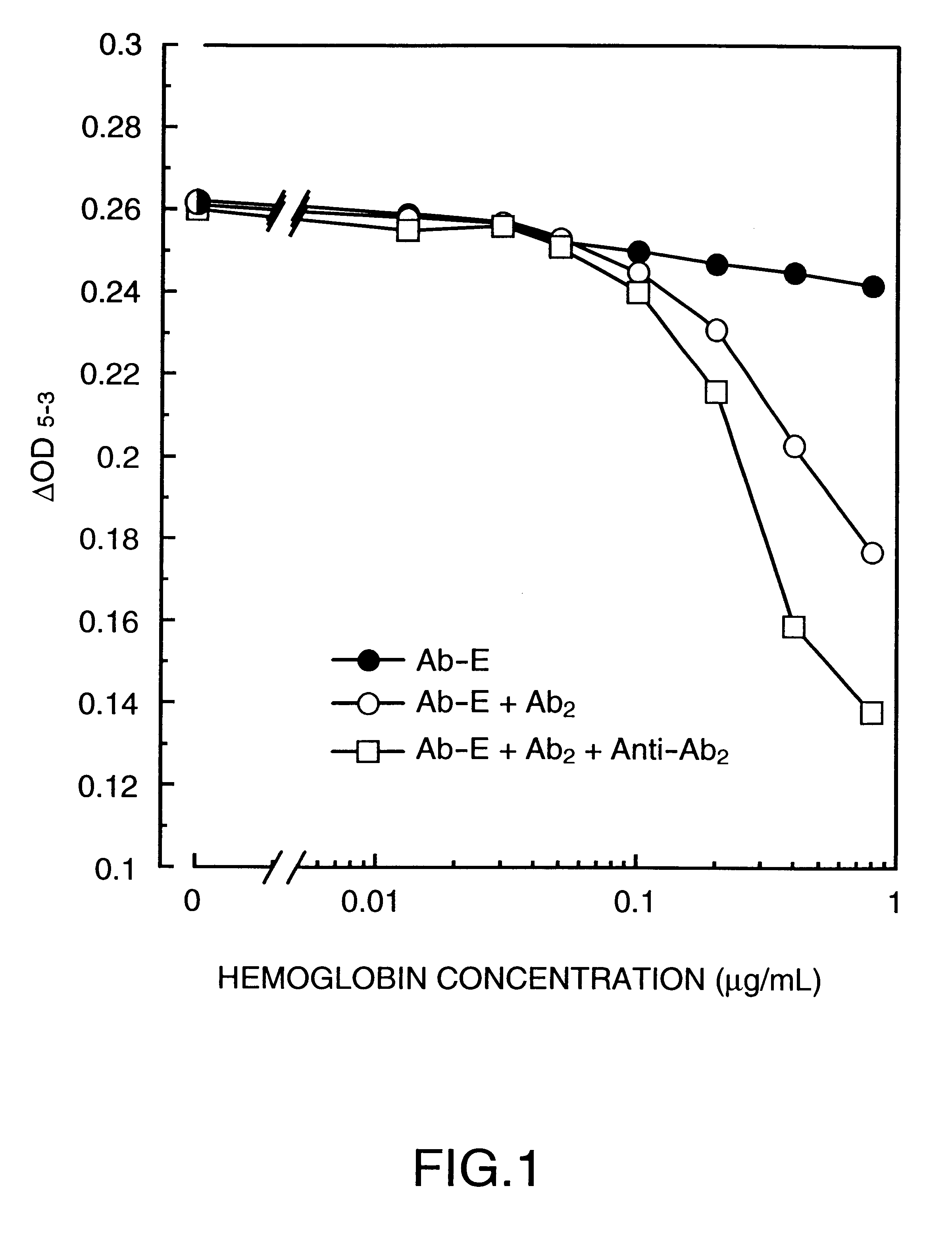Homogenous enzyme immunoassay process
a technology of homologous enzymes and immunoassays, which is applied in the field of homologous enzyme immunoassays, can solve the problems of the active site of the labeling enzyme generally suffering steric hindrance by the antigen, and achieves the effect of high sensitive analysis and simple operation
- Summary
- Abstract
- Description
- Claims
- Application Information
AI Technical Summary
Benefits of technology
Problems solved by technology
Method used
Image
Examples
example 1
Preparation of Anti-human Hemoglobin IgG
Each of two different monoclonal antibodies IgG against the human Hb (hemoglobin) was prepared through a conventional process in which immunized cells (spleen cells) obtained by the immunization of a mouse were fused with murine myeloma cells, followed by cloning process. The below-described Fab' fragment for the first antibody was prepared from one of the two different monoclonal antibodies, after confirming that each monoclonal antibody specifically recognizes different epitopes of the same antigen. The other monoclonal antibody (IgG) was used as the second antibody in the below-described Examples 6 and 7.
example 2
Preparation of Anti-Human Hb IgG Fab' (First Antibody)
4.4 mg of the first anti-human Hb antibody IgG was dissolved in 1 mL of a 0.1 M acetate buffer (pH 5.5) and then added with 132 .mu.g of activated papain, followed by stirring the mixture at 37.degree. C. for 2 hours. The reaction mixture was then applied to a SUPERDEX-200 gel column, which had been preliminarily equilibrated with a 0.1 M phosphate buffer (pH 6.0, containing 1 mM EDTA-2Na), followed by elution with the same phosphate buffer. The peak fraction of the eluate having a molecular weight of about 100,000 daltons was collected to obtain an anti-human Hb IgG F(ab').sub.2. 5 mL of 0.1 M phosphate buffer (pH 6.0) containing 2.2 mg of the thus prepared anti-human Hb IgG F(ab').sub.2 was added with 100 .mu.L of a 113 mg / mL aqueous solution of 2-mercaptoethylamine-HCl salt to proceed the reaction at 37.degree. C. for 2 hours with stirring. The reaction mixture was subjected to gel filtration by a SEPHADEX G-25, which had been...
example 3
Preparation of GMB Amylase:
Maleimide groups were introduced into .alpha.-amylase through the following processing steps. To 1 mL of a 10 mg / mL Bacillus subtilis .alpha.-amylase solution (in a 0.1 M glycero-phosphate buffer solution, pH 7.0), 100 .mu.L of a 100 mg / mL solution of GMBS (N-(.gamma.-maleimidobutyryloxy)succinimide; produced by DOJIN KAGAKU) in DMF was added and allowed to react at room temperature for 2 hours. The reaction mixture was subjected to the gel filtration through a SEPHADEX G-25 column, and the passing fraction was collected to obtain (N-(.gamma.-maleimidobutyryloxy)amidated amylase (GMB amylase). The concentration of the thus obtained GMB amylase solution was 1.12 mg / mL.
PUM
| Property | Measurement | Unit |
|---|---|---|
| molecular weight | aaaaa | aaaaa |
| molecular weight | aaaaa | aaaaa |
| weight ratio | aaaaa | aaaaa |
Abstract
Description
Claims
Application Information
 Login to View More
Login to View More - R&D
- Intellectual Property
- Life Sciences
- Materials
- Tech Scout
- Unparalleled Data Quality
- Higher Quality Content
- 60% Fewer Hallucinations
Browse by: Latest US Patents, China's latest patents, Technical Efficacy Thesaurus, Application Domain, Technology Topic, Popular Technical Reports.
© 2025 PatSnap. All rights reserved.Legal|Privacy policy|Modern Slavery Act Transparency Statement|Sitemap|About US| Contact US: help@patsnap.com

